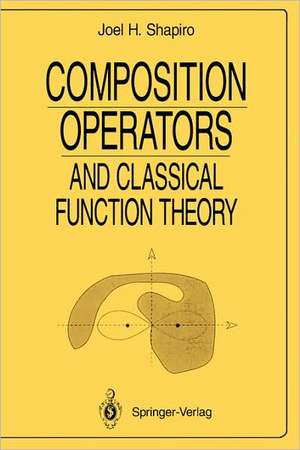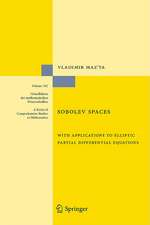Composition Operators: and Classical Function Theory: Universitext
Autor Joel H. Shapiroen Limba Engleză Paperback – 26 aug 1993
Din seria Universitext
- 13%
 Preț: 353.49 lei
Preț: 353.49 lei -
 Preț: 487.96 lei
Preț: 487.96 lei - 15%
 Preț: 543.75 lei
Preț: 543.75 lei -
 Preț: 418.67 lei
Preț: 418.67 lei - 20%
 Preț: 628.22 lei
Preț: 628.22 lei -
 Preț: 322.62 lei
Preț: 322.62 lei - 17%
 Preț: 364.82 lei
Preț: 364.82 lei -
 Preț: 634.38 lei
Preț: 634.38 lei - 17%
 Preț: 427.32 lei
Preț: 427.32 lei - 13%
 Preț: 355.52 lei
Preț: 355.52 lei - 17%
 Preț: 431.50 lei
Preț: 431.50 lei - 19%
 Preț: 429.21 lei
Preț: 429.21 lei - 19%
 Preț: 393.95 lei
Preț: 393.95 lei -
 Preț: 360.08 lei
Preț: 360.08 lei -
 Preț: 358.44 lei
Preț: 358.44 lei - 13%
 Preț: 389.95 lei
Preț: 389.95 lei -
 Preț: 465.61 lei
Preț: 465.61 lei -
 Preț: 371.99 lei
Preț: 371.99 lei - 15%
 Preț: 497.22 lei
Preț: 497.22 lei - 15%
 Preț: 737.46 lei
Preț: 737.46 lei - 17%
 Preț: 394.41 lei
Preț: 394.41 lei - 15%
 Preț: 509.58 lei
Preț: 509.58 lei - 17%
 Preț: 427.68 lei
Preț: 427.68 lei - 8%
 Preț: 495.44 lei
Preț: 495.44 lei - 17%
 Preț: 364.57 lei
Preț: 364.57 lei - 17%
 Preț: 369.08 lei
Preț: 369.08 lei -
 Preț: 396.55 lei
Preț: 396.55 lei - 15%
 Preț: 553.33 lei
Preț: 553.33 lei - 17%
 Preț: 365.35 lei
Preț: 365.35 lei -
 Preț: 356.78 lei
Preț: 356.78 lei -
 Preț: 673.45 lei
Preț: 673.45 lei - 17%
 Preț: 426.76 lei
Preț: 426.76 lei - 20%
 Preț: 569.56 lei
Preț: 569.56 lei -
 Preț: 372.87 lei
Preț: 372.87 lei -
 Preț: 319.07 lei
Preț: 319.07 lei -
 Preț: 379.86 lei
Preț: 379.86 lei -
 Preț: 445.88 lei
Preț: 445.88 lei -
 Preț: 382.36 lei
Preț: 382.36 lei - 15%
 Preț: 533.72 lei
Preț: 533.72 lei - 15%
 Preț: 496.02 lei
Preț: 496.02 lei - 15%
 Preț: 474.82 lei
Preț: 474.82 lei -
 Preț: 389.70 lei
Preț: 389.70 lei -
 Preț: 484.08 lei
Preț: 484.08 lei - 15%
 Preț: 643.48 lei
Preț: 643.48 lei -
 Preț: 415.02 lei
Preț: 415.02 lei - 15%
 Preț: 602.25 lei
Preț: 602.25 lei - 20%
 Preț: 510.24 lei
Preț: 510.24 lei - 15%
 Preț: 588.37 lei
Preț: 588.37 lei -
 Preț: 381.59 lei
Preț: 381.59 lei
Preț: 468.44 lei
Preț vechi: 551.10 lei
-15% Nou
Puncte Express: 703
Preț estimativ în valută:
89.66€ • 97.43$ • 75.37£
89.66€ • 97.43$ • 75.37£
Carte tipărită la comandă
Livrare economică 21 aprilie-05 mai
Preluare comenzi: 021 569.72.76
Specificații
ISBN-13: 9780387940670
ISBN-10: 0387940677
Pagini: 223
Ilustrații: XVI, 223 p. 6 illus.
Dimensiuni: 155 x 235 x 13 mm
Greutate: 0.35 kg
Ediția:Softcover reprint of the original 1st ed. 1993
Editura: Springer
Colecția Springer
Seriile Universitext, Universitext: Tracts in Mathematics
Locul publicării:New York, NY, United States
ISBN-10: 0387940677
Pagini: 223
Ilustrații: XVI, 223 p. 6 illus.
Dimensiuni: 155 x 235 x 13 mm
Greutate: 0.35 kg
Ediția:Softcover reprint of the original 1st ed. 1993
Editura: Springer
Colecția Springer
Seriile Universitext, Universitext: Tracts in Mathematics
Locul publicării:New York, NY, United States
Public țintă
ResearchCuprins
0 Linear Fractional Prologue.- 0.1 First Properties.- 0.2 Fixed Points.- 0.3 Classification.- 0.4 Linear Fractional Self-Maps of U.- 0.5 Exercises.- 1 Littlewood’s Theorem.- 1.1 The Hardy Space H2.- 1.2 H2 via Integral Means.- 1.3 Littlewood’s Theorem.- 1.4 Exercises.- 1.5 Notes.- 2 Compactness: Introduction.- 2.1 Compact Operators.- 2.2 First Class of Examples.- 2.3 A Better Compactness Theorem.- 2.4 Compactness and Weak Convergence.- 2.5 Non-Compact Composition Operators.- 2.6 Exercises.- 2.7 Notes.- 3 Compactness and Univalence.- 3.1 The H2 Norm via Area Integrals.- 3.2 The Theorem.- 3.3 Proof of Sufficiency.- 3.4 The Adjoint Operator.- 3.5 Proof of Necessity.- 3.6 Compactness and Contact.- 3.7 Exercises.- 3.8 Notes.- 4 The Angular Derivative.- 4.1 The Definition.- 4.2 The Julia-Carathéodory Theorem.- 4.3 The Invariant Schwarz Lemma.- 4.4 A Boundary Schwarz Lemma.- 4.5 Proof that (JC 1) ?(JC 2).- 4.6 Proof that (JC 2) ?(JC 3).- 4.7 Angular derivatives and contact.- 4.8 Exercises.- 4.9 Notes.- 5 Angular Derivatives and Iteration.- 5.1 Statement of Results.- 5.2 Elementary Cases.- 5.3 Wolff’s Boundary Schwarz Lemma.- 5.4 Contraction Mappings.- 5.5 Grand Iteration Theorem, Completed.- 5.6 Exercises.- 5.7 Notes.- 6 Compactness and Eigenfunctions.- 6.1 Königs’s Theorem.- 6.2 Eigenfunctions for Compact C?.- 6.3 Compactness vs. Growth of ?.- 6.4 Compactness vs. Size of ? (U).- 6.5 Proof of Riesz’s Theorem.- 6.6 Exercises.- 6.7 Notes.- 7 Linear Fractional Cyclicity.- 7.1 Hypercyclic Fundamentals.- 7.2 Linear Fractional Hypercyclicity.- 7.3 Linear Fractional Cyclicity.- 7.4 Exercises.- 7.5 Notes.- 8 Cyclicity and Models.- 8.1 Transferenc from Models.- 8.2 From Maps to Models.- 8.3 A General Hypercyclicity Theorem.- 8.4 Exercises.- 8.5 Notes.- 9 Compactnessfrom Models.- 9.1 Review of Königs’s Model.- 9.2 Motivation.- 9.3 Main Result.- 9.4 The Hyperbolic Distance on U.- 9.5 The Hyperbolic Distance on G.- 9.6 Twisted Sectors.- 9.7 Main Theorem: Down Payment.- 9.8 Three Lemmas.- 9.9 Proof of the No-Sectors Theorem.- 9.10 Exercises.- 9.11 Notes.- 10 Compactness: General Case.- 10.1 Motivation.- 10.2 Inadequacy of Angular Derivatives.- 10.3 Non-Univalent Changes of Variable.- 10.4 Decay of the Counting Function.- 10.5 Proof of Sufficiency.- 10.6 Averaging the Counting Function.- 10.7 Proof of Necessity.- 10.8 Exercises.- 10.9 Notes.- Epilogue.- References.- Symbol Index.- Author Index.














